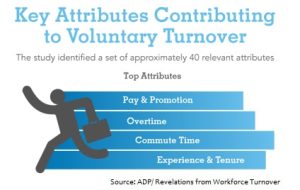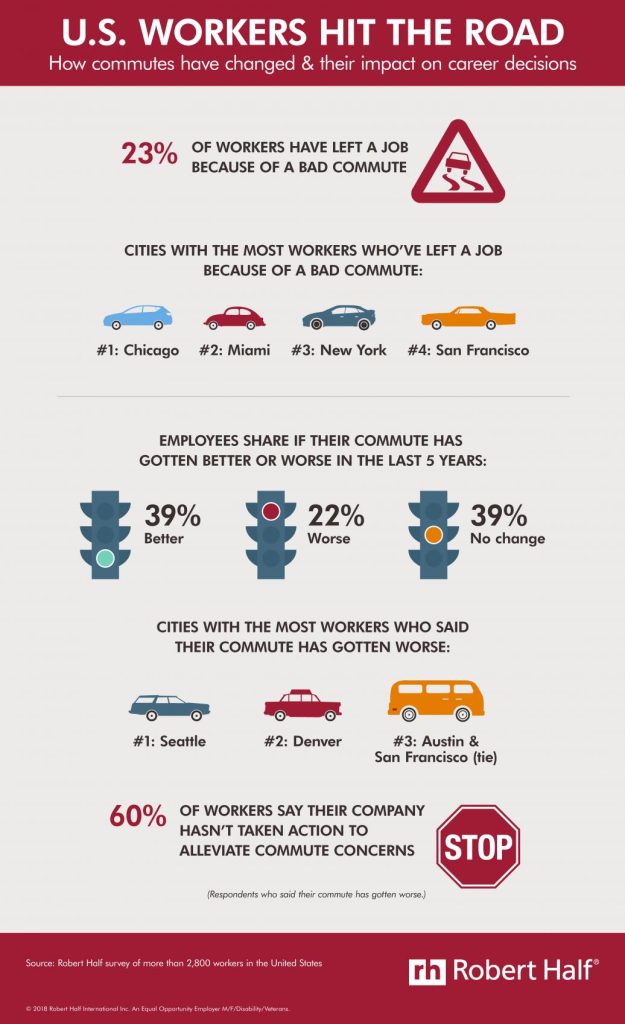There is dissonance between the causes of employee attrition and the actions companies are taking to address it. HR departments, in particular, have yet to address a mounting threat to employee well-being: the commute.
In 1942, the US workforce enjoyed a 4.7% unemployment rate; a year later, after the US entered World War II, it would fall to 1.9%. To help curb inflation during that wartime boom, the federal government limited employers’ ability to raise worker wages, so employers began offering subsidized healthcare plans to entice potential employees.
Today, we find ourselves in a similar economic climate. The unemployment rate is hovering around 4% and the shortage of talent relative to business growth is expected to continue. In this version of labor market déjà vu, employers need another way to attract talent.
Commuting costs employers
Research from ADP shows that an employee’s commute time plays a key role in driving voluntary turnover. A recent Robert Half survey found that nearly 25% of employees have left a job as a result of a painful commute. Yet, according to a SHRM survey, just 13% of employers offer a transit subsidy, and only4% offer a carpooling subsidy. Furthermore, 60% of respondents to the Robert Half survey felt their company had “not taken steps to reduce the burden on employees.”
Not only are employees put off by long commutes, but they would even pay to shorten their travel time. According to LinkedIn, 85% of U.S. professionals would take a pay cut if it meant reducing their commute time. Furthermore, researchers from the University of West England found that “an additional 20 minutes of commuting each working day is equivalent to a 19% annual pay cut when it comes to measuring how satisfied people say they are with their jobs.”
Commutes are only lengthening, which suggests the actual cost, in dollars and well-being, will only continue to increase.
The fact that employees are willing to make a dollars-to-commute-time trade-off is one more piece of mounting evidence that there is too much at stake — employee well-being and retention, among others — for leaders to ignore the commute. To attract and retain talent, HR executives must prioritize the commute as a benefit they offer their employees. In fact, commute should become the new healthcare.
Commutes are growing longer
There are factors beyond historical labor market similarities that make the commute rife for disruption. With younger Americans migrating toward dense urban cores, this population growth has caused commercial and residential real estate prices to balloon. That is forcing those looking for more affordable housing options – particularly those workers with families – to live farther away from their offices. Commute times are lengthening: The current average one-way commute in the U.S. is about 27 minutes, up from 21 minutes in 1980, according to U.S. Census data. And more people are driving to work in single-occupancy vehicles (SOVs). Increasing car density means parking structures are overwhelmed and employers must find ways to do more with less real estate.
The employee commute, once thought to be solely an employee responsibility, increasingly impacts the employer’s bottom line. Most employees consider the length of the commute when looking for jobs, and many say the commute impacts their job satisfaction. Even more importantly, employees with longer commutes are more likely than their short-distance-traveling counterparts to have health problems. Adding to the cost on employer health premiums is the cost of replacing workers leaving for jobs closer to home.
Yet, HR managers must push their organizations to go beyond just covering transportation costs, as that action alone may end up in more single-occupancy vehicle trips. Instead, HR executives should encourage shared transportation modes, such as carpooling. These types of solutions offer a dual positive impact: They solve for the increasingly limited parking infrastructure with which companies find themselves, and they improve employee morale.
What you can do
To turn the commute into a differentiated employer offering, leaders should take several steps:
- Add questions on commute length, mode, satisfaction, and parking to employee surveys to understand the specific commuting pain points.
- Frame a specific commute-related business case based on the survey responses for the organization based on real estate, people, or sustainability pain points or priorities.
- Evaluate different commute options and develop an investment roadmap to address critical areas of the solution to address the commute.
- Educate employees on their commute options and train managers to identify employees that may be struggling with a challenging commute.
- Work with local governments and transportation demand management organizations to examine how companies that provide enterprise commuting options can collaborate with public organizations to collectively address commute-related pain points.
Commute is the new healthcare
It is an ideal time to address the myriad issues caused by commuting in one fell swoop. The current economic environment is similar to that which existed in the 1940s and ‘50s, when healthcare became the de facto standard for employer-sponsored benefits. The commute is the new healthcare, and it’s time business leaders began addressing it as such.
